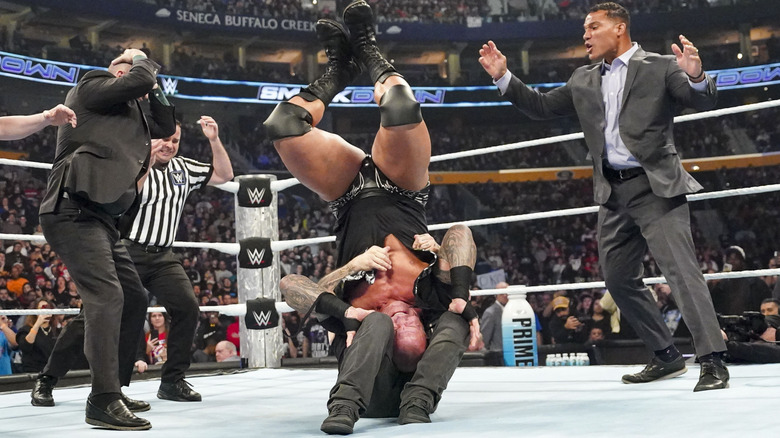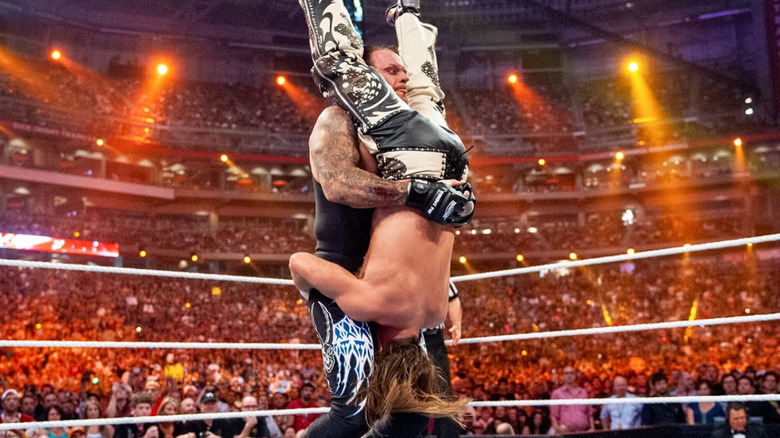What Is A Piledriver And Why Did WWE Ban It?
In a rare scene, the piledriver has been used not once, but twice on WWE television in recent weeks, with the first being taken by Randy Orton on the November 8 episode of "WWE SmackDown." The latest one came as a package variant against Undisputed WWE Champion Cody Rhodes in the aftermath of WWE Saturday Night's Main Event. Both of them, however, came courtesy of Kevin Owens, who is now touting himself as the "true" WWE Champion.
For nearly 25 years, WWE has considered the piledriver a prohibited move, with few exceptions, as it carries serious risks. What exactly is a piledriver, though?
"Wild" Bill Longson, a former three-time NWA World Heavyweight Champion, is widely credited with innovating the wrestling move. In its most basic form, the piledriver consists of one wrestler inverting their opponent and dropping them head-first onto the mat while either in a sitting or kneeling position. This basic move, of course, has expanded to now include several variations, such as the aforementioned package piledriver used by Kevin Owens. Elsewhere, AEW's Deonna Purrazzo and NJPW's Minoru Suzuki utilize a cradle version, in which a wrestler holds their opponent upside-down facing the same direction, then hooks their arms around one leg of the opponent and spikes them to the mat. Another popular iteration is the reverse piledriver, also known as the belly-to-belly piledriver, with the likes of WWE Hall of Famer Rikishi and AEW's Rey Fenix using it.
Prior to its 2000 ban, a number of in-ring performers regularly utilized the piledriver under the banner of WWE/WWF, such as Bret "The Hitman" Hart, Jerry "The King" Lawler, Paul Orndorff, The Undertaker, and Kane. Over the course of his respective career, The Undertaker popularized the kneeling reverse piledriver, which he called The Tombstone.
WWE Bans The Piledriver Over Safety Concerns
Despite the move being quite common throughout the 1980s and 1990s, WWE later banned the piledriver in 2000 over concerns for wrestlers' safety, specifically related to their head and neck. In most cases, the correct way to deliver a piledriver is to ensure that the head of one's opponent is tucked between their legs before dropping to the mat. If an opponent's head is not properly protected and is instead still protruding, however, the head may aggressively collide with the mat, causing potential spinal cord and head injury. As such, only those granted special permission, such as seasoned veterans The Undertaker and Kane, were allowed to use the move going forward.
One of the most infamous examples of a botched piledriver occurred at WWE's 1997 SummerSlam pay-per-view, when Owen Hart defended the Intercontinental Championship against "Stone Cold" Steve Austin. Toward the end of the title match, Hart looked to lay out Austin with a reverse piledriver. Unfortunately, Austin's head was not protected and thus dropped straight onto the mat beneath him. This move resulted in temporary paralysis and a bruised spinal cord for Austin, and ultimately served as a catalyst (alongside knee injuries) for his eventual in-ring retirement in 2003.
In storyline, the recent piledrivers from Kevin Owens have left both Randy Orton and Cody Rhodes with spinal cord-related injuries. In Orton's case, he was diagnosed with a cervical cord neurapraxia, while Rhodes sustained an axial compression of the cervical spine as well as a cervical strain with spasm. There is no word on when either of them will return to television.

